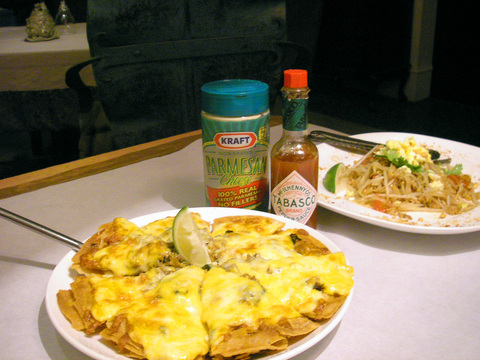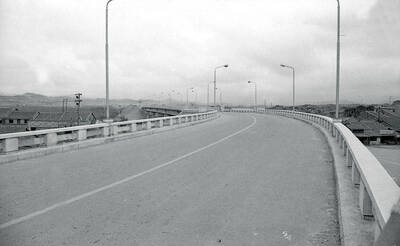Luk Kreung means mixed-blood in Thai, and refers both to mixed ethnicity of restaurant owner Tseng Hsu-min (曾旭民), as well as the mixed parentage of the cuisine that he presents — an innovative combination of Italian and Thai.
When living in Thailand, Tseng, 36, said he frequented a restaurant that cooked Italian food in a Thai style. He believed that this combination would prove popular in Taiwan as well, so two years ago he opened Luk Kreung in Taipei's trendy East District.
On its Chinese-English menu, there is an image of the Virgin Mary, representing Italian food, and one of the Buddha, representing Thai food. These are combined to create his “mixed blood” cuisine.

PHOTO: GINGER YANG, TAIPEI TIMES
This leads to some interesting combinations. There is da-pao pork, a dish of thinly sliced boiled pork with various garnishes, which is a regular feature at many Indo-Chinese themed restaurants. But in this case, it is served on a cornmeal pizza crust (NT$250), with the addition of minced meat and basil. Restaurant manager, Lai Chien-an (賴建安) said it was especially popular as a take out order.
Italian-style fried rice noodles (NT$220) uses anchovies to enhance the flavor of the traditional Thai dish, and can be fine tuned to individual tastes with sugar, ground peanuts and lemon, which are served on the side of the plate. The deep fried trout with Thai apple dressing (NT$480) and grilled beef tenderloin in green curry sauce (NT$700) are worth trying.
Luk Kreung mixes it up with the decor as well; half decorated in palatial Italian style and the other half featuring Thai-themed furniture. The furnishings are uniformly both comfortable and stylish. In fact, the establishment could easily be mistaken for a high-class furniture shop if you don't look too carefully.
There are two rooms for private functions that seat up to 12 people.
The setting is much more luxurious than you would expect for the menu's price range. “We spent more than six months designing the menu and settings. We let our imaginations run wild. Running this restaurant isn't work, it's play,” Lai said. Service is stylish, but not particularly efficient.
After the kitchen closes, Luk Kreung transforms itself into a lounge bar that serves a wide range of spirits and wine. If you want to reserve a seat, call after 5 pm.

Last week, Viola Zhou published a marvelous deep dive into the culture clash between Taiwanese boss mentality and American labor practices at the Taiwan Semiconductor (TSMC) plant in Arizona in Rest of World. “The American engineers complained of rigid, counterproductive hierarchies at the company,” while the Taiwanese said American workers aren’t dedicated. The article is a delight, but what it is depicting is the clash between a work culture that offers employee autonomy and at least nods at work-life balance, and one that runs on hierarchical discipline enforced by chickenshit. And it runs on chickenshit because chickenshit is a cultural

My previous column Donovan’s Deep Dives: The powerful political force that vanished from the English press on April 23 began with three paragraphs of what would be to most English-language readers today incomprehensible gibberish, but are very typical descriptions of Democratic Progressive Party (DPP) internal politics in the local Chinese-language press. After a quiet period in the early 2010s, the English press stopped writing about the DPP factions, the factions changed and eventually local English-language journalists could not reintroduce the subject without a long explanation on the context that would not fit easily in a typical news article. That previous

By far the most jarring of the new appointments for the incoming administration is that of Tseng Wen-tsan (鄭文燦) to head the Straits Exchange Foundation (SEF). That is a huge demotion for one of the most powerful figures in the Democratic Progressive Party (DPP). Tseng has one of the most impressive resumes in the party. He was very active during the Wild Lily Movement and his generation is now the one taking power. He has served in many of the requisite government, party and elected positions to build out a solid political profile. Elected as mayor of Taoyuan as part of the

April 29 to May 5 One month before the Taipei-Keelung New Road (北基新路) was set to open, the news that US general Douglas MacArthur had died, reached Taiwan. The military leader saw Taiwan as an “unsinkable aircraft carrier” that was of huge strategic value to the US. He’d been a proponent of keeping it out of Chinese Communist Party (CCP) hands. Coupled with the fact that the US had funded more than 50 percent of the road’s construction costs, the authorities at the last minute renamed it the MacArthur Thruway (麥帥公路) for his “great contributions to the free world and deep